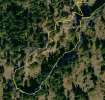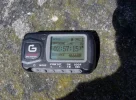Orafo
Member
- Time of past OR future Camino
- Past: Camino Francés, SJPP to Santiago and Finisterre (Sept.-Oct. 2013); Planned: Camino del Salvador-Camino Primitivo-Camino Francés-Camino Finisterre (Sept.-Oct. 2014)
I recall that some have posted suggestions for various apps that work with the iPhone or other teléfonos inteligentes, so I thought I would share the results of an experiment I did yesterday while on a training hike for the Camino. I hiked a mountainous section of a trail here in Western North Carolina using a handheld Garmin GPS as well as these apps on my iPhone: GPS Kit, Runkeeper, MapMyHike, and ViewRanger. After something less than four hours of hiking, I could see that I was losing battery power in the iPhone and that it would not last for the duration of the hike, so I wrote down the readings at that particular point in the trail. The results were not very consistent:
Garmin: 8.56 miles
GPS Kit: 10.82 miles
Runkeeper: 9.94 miles
ViewRanger: 9.05 miles
MapMyHike: 12.18 miles (!) (This could be an aberration explained by not clearing the data from a previous walk; I will try the experiment again on my next hike, making sure all data has been cleared).
So how does one know which is the more accurate? The Garmin has what seems to be a better antenna and was on my belt as I walked, more exposed to the sky. The iPhone was in my pocket, though of course all the apps on it were subjected to the same conditions.
I don't really plan to use any of these for my Camino trek next month, but I know some people like to use a GPS, so I thought there may be interest in such a wide variation among devices.
Garmin: 8.56 miles
GPS Kit: 10.82 miles
Runkeeper: 9.94 miles
ViewRanger: 9.05 miles
MapMyHike: 12.18 miles (!) (This could be an aberration explained by not clearing the data from a previous walk; I will try the experiment again on my next hike, making sure all data has been cleared).
So how does one know which is the more accurate? The Garmin has what seems to be a better antenna and was on my belt as I walked, more exposed to the sky. The iPhone was in my pocket, though of course all the apps on it were subjected to the same conditions.
I don't really plan to use any of these for my Camino trek next month, but I know some people like to use a GPS, so I thought there may be interest in such a wide variation among devices.

























